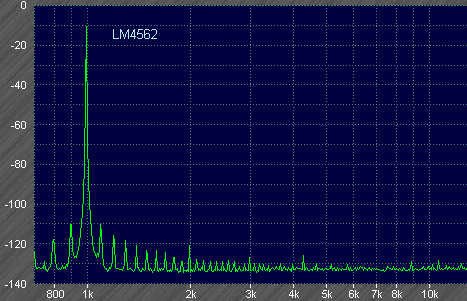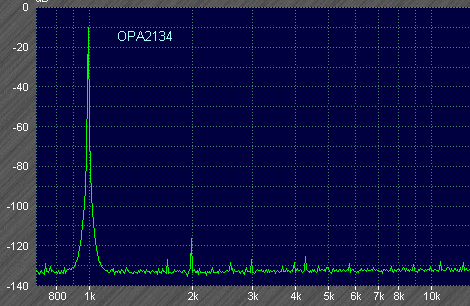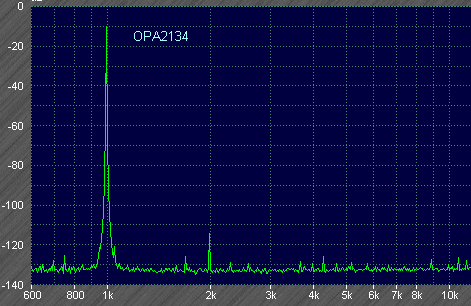Low Distortion Signal Generator Design. Part 3.
A Single Frequency Twin-T Generator
The first curcuit built is a basic version of the twin-T oscillator from part 2. The circuit is shown next:

The output level was set to 3.8V peak to peak, not for any good reason, the first aim was to compare a few different op-amps before trying to further optimise the circuit. The op-amps were TL072, LM4562 and OPA2134.
The distortion spectra are shown next, in all cases the 500k feedback level control was set to maximum resistance. Clearly this is not the maximum value allowing oscillation, so some further improvement should be possible. For later tests the 5k6 shown with a dotted connection was added.



These were not entirely what I had expected. The TL072 is rather ancient, but even so was not far behind the two 'ultra-low distortion' types. Used as an inverting amplifier most op-amps perform reasonably well at 1kHz. All three op-amps produced more second harmonic than third. The most baffling result however is the LM4562, which appears to have the lowest 2nd and 3rd harmonics, but has additional components at very close to 100Hz intervals. The board is powered from 9V rechargeable batteries, so it is not a mains supply frequency problem. I had thought there may be some stability problems with this op-amp, its 55MHz gain-bandwidth specification is worrying, and suggests far more care is needed with layout. I built the circuit on a piece of veroboard, but included the sometimes recommended 100n capacitor between the op-amp supply pins. I can easily believe that layout is the cause of the problem, but why there would be frequency components at almost exactly 100Hz intervals remains a mystery, there was nothing obvious at 100Hz to cause an intermodulation effect.
UPDATE: I mentioned in my 'Latest News' June 2017:
I found a similar result described on diyaudio starting here and an explanation in post 6928 that the 100Hz interval components were caused by a nearby DECT base station (cordless phone) which I also have operating within a few feet of where I tested the oscillator. The 55MHz GBW of the LM 4562 may be why this was the only op-amp tested to have this problem.
Anyway, not wanting to spend much time trying to solve that problem I decided to stick with the OPA2134. Its more modest 8MHz gain bandwidth is maybe more compatible with my seriously sub-optimum experimental layout.
Looking at the data sheet for another ultra-low distortion op-amp, the LME49990, supply bypassing using three parallel capacitors with different values and dielectrics is suggested, for reasons not explained other than being 'from experiment'. I have occasionally in the past used parallel capacitors without much thought, but having concluded that this serves no useful purpose and abandoned the practice I would have liked to see some theoretical justification. There is some evidence of potential problems with parallel resonances when parallel capacitors of different values are used, e.g. see here. Choosing a single supply bypassing capacitor of a few uF with leads close together and as short as possible to minimise series inductance is my approach for most audio applications.Using the OPA2134, by adjusting the 220R in the twin-T the 3rd harmonic could be reduced to -120dB relative to the 1kHz fundamental, but the 2nd harmonic changed very little. Reducing the 500k feedback level control the 3rd increased far more than the 2nd. The obvious conclusion is that the 2nd harmonic is op-amp distortion, and the 3rd is from the lamp. The lamp could also add some 2nd harmonic if there is a dc component applied to it, but there should only be a very low level of dc resulting from the op-amp offsets. Op-amp distortion could be a real problem because of the relatively low supply voltage and the loading effect of the twin-T filter. Even so the 2nd harmonic is higher than I would expect from the op-amp specifications. The OPA2134 data sheet does show the relative levels of 2nd and 3rd, with the 2nd significantly higher.
There are a few non-harmonic components, e.g. around 4.3kHz, but no screening box was used during these tests, so with a metal case this should be much improved.
Further attenuation of the feedback through the 500k preset by adding a 5k6 to earth at the junction with the 56k resistor confirmed that the feedback needed for oscillation could be reduced much further, and the preset could still be set to its maximum resistance, at which point the 3rd harmonic had disappeared from view, somewhere under -123dB. Evidently the bulb distortion is not the greatest problem, but why the 2nd harmonic is so high is not clear. Maybe my original idea to use a discrete component amplifier is the way to go. A distortion measurement using a twin-T filter to reduce the 1kHz fundamental is also needed to measure beyond -123dB.Here is an example of the OPA2134 circuit spectrum with 3rd harmonic reduced below visibility. I had also tried a few layout changes, but the 2nd harmonic remained. Adjustment of the various presets became very critical however, so although the bulb compensation method is found to be capable of low 3rd harmonic I think it is time to abandon the twin-T circuit and try one of the other options.
